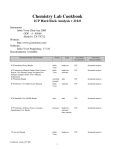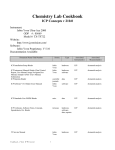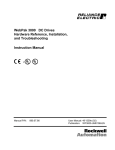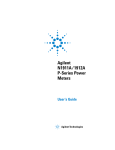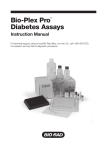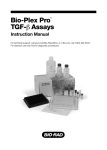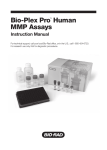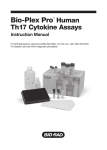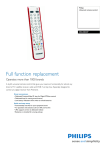Download ICP IW cookbook
Transcript
Chemistry Lab Cookbook ICP Interstitial Water Analysis v 210.0 Instrument: Jobin Yvon Ultra-Ace 2000 ODP #: 05669 Model #: TX-TF722 Website: http://www.jyemission.com/ Software: Jobin Yvon Proprietary, V 5.10 Documentation Available: Document Name/Title/Number ICP Installation/Setup Binder Source Type Associated Instrument(s) Associated Measurement(s) Jobin Yvon Jobin Yvon hardware ICP elemental analysis hardware, software ICP elemental analysis scientific journals Jobin Yvon data ICP elemental analysis software ICP elemental analysis ICP Standards Cert./MSDS Binder misc. data ICP elemental analysis ICP Technotes, Software Notes, Concepts, Spreadsheets, Etc. Binder in-house hardware, software, data, reprints ICP elemental analysis JY Service Manual Jobin Yvon hardware ICP elemental analysis ICP Instrument Manuals Binder (Final Control Report; User Manual; Image NavigatorUser Manual; Sampler AS421 User's Manual; Schematics) ICP Reprints Binder ICP Software V5.1 Binder (User Manual) Cookbook – Chem_ICP IW 1 ICP COOKBOOK FOR PORE WATER ANALYSIS (V. 210) A. Preparation of Standards (excluding Ba) For pore water analysis, a surface sea water solution spiked with reference solutions of Li, Sr, Mn, Fe, and B is used as a master standard (Master) from which serial dilutions are made (2 step dilution process). From the master standard, a set of seven intermediates standards are made (Interims I0 to I6). From the interims standards are constructed seven calibrations standards (C0 to C6) via ten-fold dilutions of the interims. Ba is not included in these calculations because of precipitation of BaSO4 that occurs when spiking seawater with Ba. Therefore, Ba has its own set of standards and will be run separately (see paragraph B). 1. Preparation of Master To make 50 ml of Master, in a 60 ml plastic bottle, dispense 37 ml of filtered surface sea water (SSW) and spike the SSW with the following amounts of reference solutions (to a total of 13 ml): 0.34 ml (340 ml) of Li; 1.37 ml (1370 ml) of Mn; 1.40 ml (1400 ml) of Fe; 8.47 ml (8470 ml) of Sr; 1.45 ml (1450 ml) of B. The concentrations in the Master of the five elements are for : Li --1000 mM, Mn--500 mM, Fe--500 mM, Sr--2000 mM, and B--3000 mM.The master can be stored in the fridge and should be stable for the entire Leg. Parafilming the bottle will help increase the shelf life. 2. Preparation of Interims The interims (I0 to I6) are made of filtered SSW spiked with the Master to achieve the following concentrations: I6 I5 I4 I3 I2 I1 I0 Vol MASTER (ml) 10 5 3 1 0.5 0.3 0 SSW Vol Total Vol (ml) 0 5 7 9 9.5 9.7 10 (ml) 10 10 10 10 10 10 10 Li B Mn Fe (µM) 1000 513 318 123 74 54 25 (µM) 3000 1708 1191 674 545 494 416 (µM) 500 250 150 50 25 15 0 Sr (µM) (µM) 500 2000 250 1045 150 663 50 281 25 186 15 147 0 90 It is easier to first dispense the SSW in all the plastic bottles (30 ml) used to store the interims, and then dispense the appropriate mls of Master to get the desired concentrations. The interims keep for a while. Parafilming the bottle will help increase the shelf life. Note: The concentrations of the five elements listed above are the theoretical concentrations entered in the calibration table of the pore water methods. Also, I0 for Li, Sr and B are 25 mM, 90 mM and 416 mM (instead of 0) respectively to account for the concentrations of Li, Sr and B in SSW. Cookbook – Chem_ICP IW 2 3. Preparation of Calibration Standards The interims standards serve as the main set of standards from which the seven calibration standards (C0 to C6) run on the machine are constructed. To make C0 to C6, dilute I0 to I6 ten times with nannopure water (1 ml standard/9 ml nannopure water). Store the standards in scintillations vials reserved for ICP pore water analysis. Dilutions can be done manually or with the Hamilton Microlab 930 dilutor (dilution scheme is saved as program 20). The calibration standards will have to be made fresh every time the machine is run. Note: The three dilutions described above can also be done using the Microlab 500 dilutor . Refer to Appendix 1 for details of various steps of three dilution Methods (IW Master, IW Interim and 10Xdil). B. Preparation of Ba Standards Ba standards are made using a “NaCl”-only matrix rather then SSW. “NaCl” refers to a 3.5% NaCl solution to mimic seawater salinity. As with the other ICP-ES standards, a Ba- Master solution is first constructed, then a series of Ba- Interims and Ba-Calibration standards. 1. Preparation of Ba- Master To make 100 ml of Ba. Master, in a 125 ml plastic bottle, dispense 72 ml of filtered 3.5% NaCl solution and spike the NaCl with 28 ml of Ba reference solution. The Ba concentration in the Ba. Master is 2039 µM. 2. Preparation of Ba-Interims From the above Ba.Master standard, five interims standards are constructed. The interims (Ba.0 to Ba.5) are made of filtered 3.5% NaCl solution with the Ba.Master to achieve the following concentrations : INTERMEDIATE Vol. Master (ml) Vol.NaCl (ml) Ba. Conc (µM) 10 7.5 5.5 3.5 1 0 0 2.5 4.5 6.5 9 10 2039 1529 1121 714 204 0 Ba.5=Ba.Master Ba.4 Ba.3 Ba.2 Ba.1 Ba.0 3. Preparation of Ba-Calibration Standards The Ba-interims standards serve as the main set of standards from which the six calibration standards (Ba.C0 to Ba.C5) run on the machine are constructed. To make Ba.C0 to Ba.C5, dilute Ba.0 to Ba.5 ten times with nannopure water (1 ml standard/9 ml nannopure water). Store the standards in scintillations vials reserved for ICP pore water analysis. Dilutions can be done manually or with the Hamilton Microlab 930 dilutor (dilution scheme is saved as program 16). The calibration standards will have to be made fresh every time the machine is run. The Ba calibration standards (Ba.C0 to Ba.C5) are run as unknown during the analytical run and a Ba regression curve is calculated off line after the run and used to establish the sample concentrations (see section L). Note: The three dilutions described above can also be done using the Microlab 500 dilutor . Refer to Appendix 2 for details of various steps of three dilution Methods (Ba Master, Ba Interim and 10Xdil). C. Preparation of Drift Solution A drift solution is measured on the ICP multiple times during an analytical run to account and correct for instrumental drift. The drift solution must be of the same matrix as the samples and standards that are being analyzed. A drift solution can be Cookbook – Chem_ICP IW 3 constructed out of filtered SSW and nannopure water spiked only with Ba, Mn and Fe. Li, B and Sr need not to be added, as their concentrations in SSW (25 mM, 416 mM and 90 mM) are high enough to be measured without the need of an additional spike. Spiking with the small amount of Ba listed does not cause precipitation of barite (Ba SO4). To make the drift solution, proceed as follows: In a liter flask, dispense 100 ml of filtered SSW, and spike it with: 545 ml of Mn reference solution; 558 ml of Fe reference solution; 6.84 ml of Ba reference solution; and Add nannopure water to make a liter. This preparation results in a ten fold dilution. However, the equivalent concentrations in undiluted sample of the various elements are the ones given by the method (see note in paragraph A.2.). They should be 25mM for Li, 90 mM for Sr, 100 mM for Mn, 100 mM for Fe, 416 mM for B and 500 mM for Ba. Note: The drift can also be made with synthetic seawater (3.5% NaCl) spiked with the same amount of Mn, Fe and Ba reference solution, however Li, Sr and B will need to be added in the following amounts: 17 ml of Li reference solution, 788 ml of Sr reference solution, and 450 ml of B reference solution. This drift is more stable then the SSW drift as Ba does not precipitate. See Appendix 3 for preparation of drift solutions using the Microlab 500 dilutor (IWDRFTSSW or IWDRFTNACL methods). D. Preparation of Rinse Solution (Rinse Time) It is necessary between each standard and each sample to rinse out the sample uptake tubing and torch glassware from any carryover from the previous standard or sample. Rinsing also helps combat clogging of the nebulizer. A 0.5% HNO3 acid rinse performs well for pore water analysis. To make a liter of 0.5% HNO3 rinse solution, add 7.14 ml of concentrated 70% HNO3 to 993 ml of nannopure water. Rinse time should be set at a minimum of 1.5 mn (90seconds). E. Preparation of Samples All samples introduced in the ICP should be filtered with a .45 m Acrodisc filter. The samples need to be acidified at time of squeezing to avoid Fe precipitation (10 ml of concentrated clean HNO3 per ml of sample). The samples are diluted to 1: 10 (1 ml sample/9 ml nannopure water) and stored in scintillations vials reserved for ICP pore water analysis. Dilutions are done manually ,or with the Hamilton Microlab 930 dilutor (program 20) or with the Microlab 500 dilutor (10X Dil or 10-1 Dil methods). All samples should be allowed to settle at room temperature prior to analysis. F. Preparing the ICP Unit for a Run. Before lighting the plasma , proceed as follows: (1) make sure that the all the ICP components (sample introduction system and torch assembly) are set up properly and clean, and (2) set up the sample file, load the autosampler rack, and position the rinse and drift solution on top of the autosampler. 1. Checking Sample Introduction System and Torch Assembly The sample introduction system for pore water analysis includes the autosampler, peristaltic pump, Teflon tubing, concentric nebulizer and spray chamber. The torch assembly consists of the torch body, inner and outer tube, alumina injector, and aerosol gas attachment. Prior to lighting the plasma: Make sure that the sample intake (black) and waste (grey) tubing are not flattened and replace if necessary; Check if nebulizer and spray chamber are clean and hooked up to appropriate tubing; Cookbook – Chem_ICP IW 4 Check if outer and inner tubes have staining or build up precipitation on their surfaces. Replace with clean tubes if necessary; Check torch alignment. 2. Set Up Sample File Sample files are specific to the method open when created. Be sure to have the correct method open before creating the sample file. To prepare the sample file , proceed as follows: In the Main Menu of the JY software, select Analysis; From the Analysis Menu, choose Sample File. Enter a file name, and choose YES when asked if you want to create a new sample file. A Sample File window will open. On top of the window, verify you have the appropriate method loaded and the correct sample file name; Enter the ID of the samples in the first field of the Sample Name Field; After entering a sample name press ENTER, then F3 to record it; Continue until all drifts, blanks (as "Zippy"), and samples have been entered; Once all samples have been entered, choose F9 to view a list of the samples; Use the arrow keys to move from sample to sample to input the correct sample position and press ENTER to save the position. Press F9 to print the list of samples with their positions (select SAM); When done, press ESC to save the changes and to return to the Sample File input page. Once the sample file is defined, the operator needs to define the transfer parameters. To do so, go back (ESC several times, Reset position-YES), ESC) to the Analysis Menu, choose Sample File and hit F5 Transfer Parameters. Repeat ENTER till you get to the Results File Name field. Type the directory where you want to sent the results and the result file name (e.g. C:\leg188\1167.F03). Repeat ENTER till the cursor appears on the top of the page. Escape all the way out of the program. A typical sample file for the pore water analysis has 45 items (11 Drifts) in the sample file and will look like the following: Drift 1 C2 Drift 2 IAPSO Sample A Drift 3 Sample B BaC1 Sample C Drift 4 Sample D Sample E C3 Sample F Drift 5 BaC0 Zippy Sample G Sample H Drift 6 Sample I BaC3 Sample J Sample K Drift 7 Sample L C5 Cookbook – Chem_ICP IW 5 BaC2 Sample M Drift 8 Sample N IAPSO Sample O SSW Drift 9 Sample P BaC5 Sample Q Sample R Drift 10 Sample S BaC4 C3 IAPSO Drift11 3. Load Autosampler and Position Rinse and Drift Solutions The user, through the sample file, controls which sample is located in what particular position on the autosampler and where the rinse and drift solutions are located. In the pore water analysis, the autosampler will be used not only for a sample run but also for calibration . Racks code 24 are used for both calibration and sample runs with place for 14 scintillations vials per rack. During a calibration, a rack code 24 with the seven standard vials in position 1 (upper left corner of rack) to 7 is placed in the notch closest to the autosampler. The rinse is usually beside the standard rack in a Teflon beaker elevated by three plastic disks. For example, the Rinse solution will be in Rack 2, position 13 (bottom right corner of rack). The rinse position is specified in the software before the calibration actually starts. During a sample run, up to 4 racks code 24 can be placed next to each other. For example, in a 45 items run, 3 racks will be used. Rack 1 includes position 1 to 14, rack 2 includes position 15 to 28, rack 3 includes position 29 to 42. The rinse and drift solutions are placed beside rack 3 in Teflon beakers labelled appropriately (raised with plastic disks). The position of the drift solution is specified in the sample file prepared in advance of the run. For example, with a 3 rack run, the drift solution can be placed in position 51. The rinse position is specified just before the sample analysis is started. In a 45 sample run, the rinse solution for example can be placed in rack 4, position 13. Noticed that the rack position is numbered differently for a rinse solution then for the drift solution. The rinse solution requires a rack number and position from 1 to 14 while the drift just requires a number to indicate what would be its position in the next rack. Note: The autosampler probe has to be positioned carefully so as to be high enough (when in the up position) to clear the tops of the autosampler vials but low enough to get as much sample out of the vials as possible. Commonly, the probe will not be able to reach the bottom 1-2 ml of sample. Once the sample file is set up, the instrument plasma needs to be lit as described below. G. Starting the ICP The start-up procedure consists of the following steps: Check sample introduction system (pump tubing), torch glassware and alignment (as described in F.1.); Turn on water re-circulator; - Make sure exhaust fan is ON Turn on Argon gas and check bottle pressure; Check Nitrogen flow and bottle pressure; Cookbook – Chem_ICP IW 6 Open the Automatism window (double click on Plasma Controls) in JY main window; Turn humidifier ON if needed (usually OFF for pore water analysis); Turn Controls ON; Check pump speed (20), plasma flow (12-14 l/mn), nebulizer flow (0.9) and pressure (around 3 bar), and reflected power. Record them in the ICP blue Notebook; Pump nannopure water for at least 5 minutes prior to lighting plasma; Light plasma by clicking on Start button; Wait 30 minutes before analysis. H. Preparing for Analysis Three procedures need to be performed before calibrating and running samples: zero order check, autosearch, autoattenuate, and profile.The letter three procedures are performed using the Preparation Menu accessed by selecting Preparation in the Main Menu of the JY software. 1. Performing a "Zero Order" check. A zero order check is performed from time to time just after the warm-up. Performing a zero order check physically moves the diffraction grating to its "zero" position, where all light is reflected back. Zero Order is the term used to define when the grating within the spectrometer behaves as a mirror and does not separate the incoming light into several wavelengths, but rather reflects it (like a mirror). The software will check as to whether "Zero Order" is ‘okay’ or not whenever you turn on the machine, however, this internal check is not a true mechanical test. Rather, it is in fact a test of whether the electronics have been compromised (i.e., turned on or off, been subjected to a surge, etc.) since the ICP was last used. Therefore, it is advisable to perform a Zero Order test (Shift-F2; Center Control) from time to time (no need to do it every day for pore water analysis) and record in the logbook at what position (step number) Zero Order was found as this parameter is useful for diagnostics should the need arise. 2. Performing an Autosearch When performing an autosearch, the spectrometer searches for a "reference peak" (the carbon line at 193.031 nm) and subsequently, when analyzing for an element (for example, Fe at 238.204 nm), moves to the desired wavelength as a function of its distance (in "motor steps", which corresponds to nm) from the reference peak. Prior to each analysis (of a sample, standard, blank, or any item) the ICP searches for the reference peak and locates it. The "autosearch" function tells the machine exactly where each peak is located with respect to the reference, so during the analysis it can locate the peak precisely. The ICP also quantifies an "offset", which is the distance (in nm) that it found the peak from where it was expected. Typical offsets are on the order of 0.005 nm or less. Offsets significantly and consistently greater than 0.005 (approximately, in practice this will depend on ODP’s exact instrument) may indicate something is amiss. To perform an Autosearch procedure, proceed as follows: Aspirate the drift solution and select Autosearch from the Preparation Menu; Select Small for the Search Window Size; Select the elements you want to autosearch. Use F10 to search for all elements. To search for only one element, press F5 to indicate YES for the element of choice and F9 to indicate NO to the others; then press F10. Check whether the ICP located the reference peak of the element(s) of interest, the shape of the peak, and the offset; If the machine is not sure it located the right peak and you are, accept with F10; Perform an autosearch repeatedly until the peaks are visually on-line each time. Note: The first time an element is autosearched, or whenever a method has been changed significantly, be sure to use a single element solution to ensure that the peak found during an autosearch is in fact a peak for the element of interest. If using a multiple element solution, use first the large then the small window option on the JY software to ensure that the peak found is the one of interest. Cookbook – Chem_ICP IW 7 3. Performing an Autoattenuate An important component of the Method is the voltage applied to photomultiplier (PMT) during the acquisition of each element. This voltage needs to be optimized, which is performed using the "Autoattenuate" command from the Preparation menu, and is performed after a Method is developed. Autoattenuating does not have to be done every day. Generally, Autoattenuate is done once when the method is created or whenever the peak shape are flat on top as seen in the Autosearch procedure (often for Sr). To perform an Autoattenuate procedure, proceed as follows: Be sure to have autosearched, so the software is indeed adjusting the voltage to the correct peak; Aspirate the highest concentration standard; Select Autoattenuate from the Preparation Menu; Select Small for the Set Voltage Window size and search all, or only some, of the elements contained in the method (same as in Autosearch). The software will perform the optimization, and the selected voltages and gains will be printed. When completed, the software will return you to the Preparation Menu. 4. Profiling A Profile is essentially a picture of the spectrum at, and around, the wavelengths specified in the Method. Profiles are especially useful because they allow the user to see potential interferences or changes in background levels. The Profile is the only command by which the user can actually see the intensity vary as a function of wavelength. While viewing a Profile, the user can select the position of the background measurement (“carrot”). This is the preferred approach to select this position (rather than directly in the Method) because adjacent peaks can be observed and the background selection thus made more informatively. To acquire a Profile, proceed as follows: Aspirate the drift solution and select Profile from the Preparation Menu; Type a Profile Name (limited to 8 characters, use date for example) and press ENTER twice; To start acquisition, press F10. The software will then ask if you want to acquire a profile for all the elements in the Method, choose YES or NO, then select or de-select elements as needed (using F5-YES or F9-NO function keys); Once the profile is completed, view the profile by pressing F3 - Go to Graphics; - A list of all Profiles acquired with the current Method will then be displayed. To select a profile use the arrows up and down to get to the profile of interest(s) and press ENTER. Up to four profiles may be viewed at once. It is a good idea to load the previous day (s) profile(s) to check for changes since the instrument was last run; While viewing, the function keys can be used to perform various tasks such as: setting and clearing background points (use the arrow keys to move the cursor), expanding the axes (F30, etc. (see list of options on the left side of the Profile display screen). Check that every element (F10) is centered on the line, check signal/noise ratio (counts at peak apex/background counts--big is better!); Press ESC when you are ready to return to the Preparation Menu. Note: Profile names are universal, regardless of the Method being used (i.e. the same Profile name cannot be used for different Profiles acquired with different Methods). I. Calibrating With the calibration rack in place in the left most position on the autosampler and the rinse bottle in the proper position, one is ready to calibrate. Proceed as follows: From the Preparation Menu, choose Calibration, then Calibrate; Choose the type of sample racks being used (24); Cookbook – Chem_ICP IW 8 Specify the Rinse Rack Number and Rinse Position on this Rack; Attach the autosampler probe tubing to the pump; Press F10 Calibrate; Press any key to start. The autosampler probe will move first to the rinse bottle then it will move to the first standard in position 1, and so on between the other 6 standards and the rinse bottle. When the measurements for the standards are finished, the autosampler will try to measure the recalibration standards STDLOW and STDHIGH (even if the user does not want to use recalibration standards). To stop the autosampler, press ESC several times until the probe returns to the rinse and the message on the bottom of the monitor asks "Reset Rinse Position?”. Select NO to leave the probe in the rinse bottle. The next step before running samples is to check the linearity of the calibration curves and make any needed adjustments. To do so: From the Preparation Menu, choose Calibration, then View Curves; Press F3 Display Results. A Calibration Coefficients window appears for the first element in the calibration table. In this window, the regression coefficient and equation, and a table of the calibration data will be displayed. For each standard level in the calibration table, check the relative errors and compare the measured concentrations (Ms Conc.) to theoretical concentrations (Th Conc); Check that the calibration is linear for that particular element by looking at its calibration curve (press F3 to view the calibration curve and F3 again to go back to the calibration table) Eliminate the standards you do not like (high errors) from the regression, either (1) directly from the curve by using the up and down arrow keys and selecting S for Suppress, or (2) by editing the calibration table itself. Choose F5 Modify to edit the calibration table. Using the right arrow key, go to the validity column (VAL) and eliminate the standards from the regression by entering a 0 (a 1 indicates the standard is used in the regression, a 0 means it is not used). When finished making modifications, press ESC to get out of the edit mode and press F9 to print the calibration data; Proceed to check the calibration data for the next element by using the right arrow keys. Be sure to save any changes made when moving on to the next element; Repeat as above for all the other elements; When you finished, escape several times till you get back to the Main Menu. Note: If performing a manual calibration, choose Calibrate and begin aspirating the lowest concentration standard (calibrations are done from low concentration to high). The next screen will then be essentially blank, with the Method name in the upper left corner and the standard name in the upper right corner. At the bottom of the screen the user will be asked if this is the standard you wish to measure (standard names will correspond to those names entered in the Method file), choose YES. After completing the measurement of the standard, you will be prompted to continue with the other standards. Follow the prompts on the screen, and aspirate the corresponding standards in order from low to high concentration. As with the autosampler, the instrument will always want to measure the recalibration standards (STDLOW and STDHIGH), but if they are not being used, choose NO when prompted to analyze these standards. J. Analyzing Samples If the operator is satisfied with the calibration, the analysis of the samples can start as soon as the sample racks, rinse and drift bottles are properly positioned on the autosampler tray. Starting the analytical run must occur as soon as possible after the calibration is completed (usually within 5 to 15 min). This is of vital importance because the first item in the Sample File is a drift solution, which is used as the master drift to correct the entire run. To perform a sample run, proceed as follows: From the Main Menu of the JY software, select Analysis; Select Sample File and type the name of the file you prepared earlier; Press F10 Analyze. You will then be prompted to “Select Racks?", choose YES, and make sure that the proper number of racks and rack types are specified; Then choose F10 Analyze again. You will then arrive at the Analysis Page, and be prompted to "Prepare the Autosampler" and to "Press any Key" to begin. Do so. As with the calibration, the autosampler will then move the probe between the samples, the drift, and the rinse bottle until all the samples and drifts have been analyzed; Cookbook – Chem_ICP IW 9 When the run is finished, the message “Reset Rinse Position” will appear. Select YES and then proceed with the shut down procedure. Note: During the run, you need to constantly monitor the ICP. Keep on eye on the level of solution in the rinse and drift bottles. Keep an eye on the sample intake tubing as it easily slips out of the pump tubing. Keep an eye on the Argon supply, the ICP sucks 100 psi in 20 mn. Make sure you always have plenty of paper in the printer, the software will crash the run if it cannot print to a printer. If the message “Reset Rinse Position” flashes in the middle of your run, go back in the run immediately (select Analysis, Sample File, F10 etc..). The software keeps in memory what samples it ran up to the crash (a m next to sample name in the sample file indicate that the sample was measured) and will restart at the appropriate sample number. However, if the run crashes again, all is lost and you will have to start from scratch. K. Shut Down Procedure. To shut down the ICP, proceed as follows: Pump rinse solution for at least 5 minutes; Pump in H2O for at least 3 minutes; Open the Automatism window in JY main window; Turn humidifier OFF if used; Press STOP to shut off the plasma; Maintain gas flow and pump H2O for another 3 minutes; Remove input tubing from H2O and continue pumping until nebulizer and spray chamber are dry; Turn Controls OFF to shut peristaltic pump off, and release clamp. Roll tubing around with fingers; Turn off recirculating water; Shut off the Argon gas bottle; Empty waste bottle, if needed. L. Post Analysis Data Reduction The data generated by the ICP can be reduced using either the calibration software or off line without the use of the calibration software. For pore water analysis of Li, Sr, Mn, Fe and B, Both options are available. For Ba , data reduction is always done off-line. A series of Excel spreadsheets have been designed to perform data reduction. During the run, the data has been saved into the directory you specified in the Transfer Parameters as a .F03 file (eg. 1167A.F03). The file is a comma delimited, ASCII text file. To perform data reduction on the raw data collected from the ICP, proceed as follows: Copy the raw data file to a floppy disk; Import the file into Excel for further off-line data reduction; Open the file from within Excel and choose, in sequence, Delimited, next, Comma, next, and finish. The output file will then be opened with all the columns and rows correctly delimited; Open a renamed duplicate of the IW ICP Data Reduction Excel spreadsheet you wish to use and paste the raw data in the “Raw Data” sheet (cell A3); 1. Data Reduction using Calibration (Murray’s spreadsheet based on concentrations) Once the raw data have been pasted in cell A3: The sample names, elements, and measured solution concentrations will be transposed automatically in the “Transposed Data” sheet (adding a new element will require to change all the transpose cell numbers); The measured concentrations for the drift samples are copied automatically to the “Drift Only Data” sheet and ratios and averaging neighboring drifts are calculated; Changes due to instrumental drift are corrected for on the “Drift Correction” sheet; Cookbook – Chem_ICP IW 10 In the Final Correction sheet, paste the corrected concentrations for the samples that have been calculated in the “Drift Corrections sheet; If the drift-corrected concentrations of the IAPSO are within range of the accepted values, there is no need for further data reduction. If additional data reduction is needed, construct a re-calibration line for each element, based on the drift-corrected concentrations of IAPSO and the known concentrations. This line will have a slope very near to unity, since it is based on the calibration concentrations and the known concentrations. Apply this secondary calibration to the drift-corrected concentrations of the samples and save them in the Final Correction sheet. 2. Off-line Data Reduction (In House spreadsheets based on raw intensities) Two Excel spreadsheets exist to work with 6 elements (one for data reduction for a 45 item run and one for 50 item run. There are 4 different pages in each spreadsheet: Raw Data; Reduction; Ba reduction; and Final Data. Once the raw data generated by the ICP software is pasted into the "Raw Data" page of one of the Excel templates, a transposition macro is run and the data will be automatically reduced and transferred to the "Final Data" sheet. Please realize that the transposition macro will not work if the number of elements run is changed, or if the raw data is offset on the data reduction page. The reduction page is sensitive to the location of the blank (Zippy), drifts, and the C2, C3 and C5 standard. If changes are made, the spreadsheet will need to be modified to fit the new output of the ICP. Comments have been made in each templates (and each sheet in the templates) to assist the user. To perform data reduction on the raw intensities collected from the ICP, proceed as follows: Copy and paste all the rows and columns from the *.F03 file to the “Raw Data” sheet (in cell A3); Run the macro "Transpose_raw_intensities" . To do so, go under the Tools menu, select Macro, then Macros, and click on Run. This will automatically transpose the raw intensities data from the “Raw Data” sheet into the “Reduction” sheet. NOTE! If elements are added or subtracted, the transpose macro will not function properly. Create a new macro or paste the values by hand; Once the macro has run, proceed directly to the “Final Data” sheet. After the macro is run, the final concentrations of the samples have been automatically transferred from the “Reduction” page to the “Final Data” page. Drift samples and zippy have been removed, while the standards are highlighted in blue and extracted to the section entitled "Standard Concentrations"; To the right of “Final Concentrations”, there is a section called "Rearranged Final Concentrations". The final sample and standards concentrations are copied and pasted in here. Similarly, the final samples and standards Ba concentrations are copied from the “Ba Reduction” sheet and pasted under the Ba heading (see below for Ba reduction procedure); Copy each sample name and concentration, one by one, into the "Extracted Sample Concentrations" section (look left and down of the spreadsheet) and this is the data set you can now copy and paste into the IW spreadsheet. Ba Concentrations are calculated using a set of calibration standards run as unknown during a sample run. To get final Ba concentration values, proceed as follows: Go the “Ba Reduction” Sheet, select cell J5 and run the macro Ba_Transpose. This will automatically paste sample names and associated Ba drift corrected intensities from the “Reduction” sheet to column J and K of the “Ba Reduction” sheet; Copy the drift corrected intensities values of the standards BaC0 to BaC5 and paste them in column C; The chart below will automatically calculate the regression equation and R2 for the calibration; To get the final Ba concentrations values, in cell L5, insert the linear regression equation (e.g.=0.0173*K7+3.1181) and then copy it to the cells below. The Ba Final Concentrations can then be copied and pasted in the “Final Data” sheet (see above). Cookbook – Chem_ICP IW 11 M. Basic Maintenance and Clean Up 1. Unclogging a Nebulizer A steady decrease in the Ar flow rate and and a rise in the back pressure are symptomatic of a clogged nebulizer. Additionally, the stability of the instrument will greatly decrease. Because of the importance of the nebulizer to the analytical process, great care needs to be taken to be prevent clogging. To unclog a nebulizer, never use an ultrasonic bath. The vibrations in such a bath will harm the delicate glass channel of the nebulizer. Because the channel of a concentric nebulizer gets successively more narrow towards the tip, never try to clean a nebulizer by forcing gas or water in the forward direction. To clean the nebulizer, concentrated nitric acid is pushed through all three orifices of the nebulizer. One should proceed as follows: First, inject concentrated HNO3 acid (wearing safety glasses and gloves) into the front tip of the nebulizer, i.e use the 70% HNO3 squeeze bottle equipped with a rubber tube that is stored in the acid hood, attach the tube to the tip of the nebulizer and squeeze acid through the tip; Then inject some acid up from the Argon channel and through the other end of the nebulizer. This will ensure that the clogged tip will be inundated from all directions; Rinse the nebulizer with nannopure water by pushing the water through all three orifices of the nebulizer (use the DI bottle fitted with a rubber tube located in the acid hood). Additionally, provided the nebulizer has been rinsed with deionized water (and thus there is no loose acid present), the nebulizer can be unclogged sometimes by unhooking one of the gas flows from the ICP torch assembly, placing the end of the tube over the tip of the nebulizer, and using the high Argon pressure to blow back through the nebulizer. Be sure to hold on to the nebulizer tightly to prevent it from launching across the room. 2. Cleaning the Quartz Glassware and Alumina Injector Tip The glassware (inner and outer tubes, spray chamber, nebulizer) and the alumina injector tip need to be cleaned on a regular basis. Frequency of cleaning depends on the number of samples run. The outer tube, inner tube, and alumina injector will build up precipitation on their surfaces. This is detrimental to the analysis because it affects plasma shape, plasma stability, and inhibits ionization of the analyte. There is a difference between precipitation build-up and staining. Staining will occur, and can be tolerated. Precipitation on the surfaces of the glassware, however, is more serious and must be monitored. The key issue is that the glassware must be smooth, with the edges unchipped and with their edges high quality. The outer quartz tube must be very clean and with minimal stains. The best way to clean the tubes is by leaving them for a long time in a concentrated HNO3 (70%) wash bottle (12 to 24h minimum). Avoid use of an ultrasonic bath. Rinse them in DI and use KimWipes or other clean cloths to rub off the outside of the tube, or pass the KimWipe through the inside of the cylinder and pass back and forth. For the inner quartz tube, it can be inverted (reversed) so the stained end is at the bottom of the torch assembly, but if this is done be sure that the edges of the tube are smooth and sharp, so the bottom of the tube is seated properly.For the alumina tip, soaking the upper end even in relatively weak HNO3 helps clean away precipitation easily. Cookbook – Chem_ICP IW 12 Document Information: Author, Original: Rick Murray Version Number, Original: 192 Revision History: 210: Chris Bennight Signature (Department Supervisor) Cookbook – Chem_ICP IW 13













